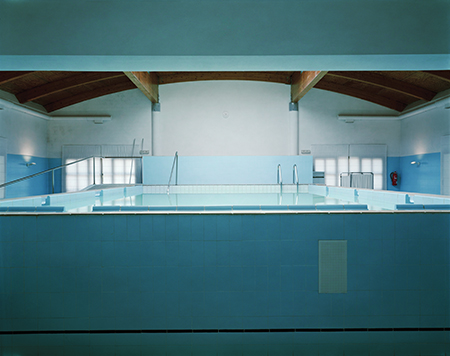Lynne Cohen

The majority of the 40 photographs by Montreal-based artist Lynne Cohen exhibited here were harvested from her most recent productions. Known for some four decades for her photographs of interior sites empty of human beings, Cohen makes images that have the power to haunt us as acutely as the abbeys in the ghost stories of M.R. James or the Red Room in David Lynch’s Twin Peaks (1990–01).
Scale helps. Red herrings abound. Eeriness abides. If their expansive size lends them unusual gravitas, an ominous tone distends from these environments into our lived space. They may seem like set pieces, but they make us want to believe. Vignettes depict specialized classrooms, science labs or military installations. One senses an unpleasant event is at hand or has just happened, or that something inauspicious or untoward is waiting in the wings. However, they are also leavened with humour and absurdity. Consider Untitled (Dog) (2006) with its blue drapes, open doors with pinkish-salmon light emanating from within and, above all, the disproportionately large guard dog image above the central doorway. Think of a still from Stanley Kubrick’s The Shining (1980). What exactly is going on here? Perhaps it’s better not to ask.
Upon first inspection, these unpeopled interiors do not appear real, but it should be noted that Cohen does not alter or intervene in any way in the sites she photographs. They pack a punch that can put your heart in your mouth. Consider Untitled (Balloons) (2007), with its three figures in the middle-left quadrant: we recognize immediately that these are not real humans but changeling dummies riddled with bullet holes. But that recognition in no way diminishes our palpable unease. Sundry limbs are missing, and others taped back on. It is as if we have violated a threshold we should not have crossed.
There is a family resemblance to Taryn Simon’s An American Index of the Hidden and Unfamiliar (2007), in that these are places we have never seen before and probably will never see in real life. Cohen has always focused on these uncanny interiors, building up a remarkable inventory of images that were initially mostly executed in black and white. She seems to choose her locations for their sheer strangeness and radically indeterminate character, and is reluctant to share their site-specificity. Now colour has been brought into the mix in a way that accentuates their implicit surreality and adds dimensionality. Images of meticulously built places for purposes that are heretofore unknown to us and that would remain unknowable but for their laconic titles, they nevertheless appear to have arrived from an extravagant elsewhere. If the medium of photography itself has been built upon a dark heart of deception, then Cohen is a beautiful liar. The works remind us of French anthropologist Marc Augé’s development, in his seminal book Non-Places: Introduction to an Anthropology of Supermodernity (1992), of the concept of ‘non-place’ in reference to places of transience that do not hold enough significance to be regarded as ‘places’. (For example, a hotel room, airport or subway station.) But Cohen’s places hew to another order of significance altogether and while they share some of the same parentheses, they get under our skin, and yield a frisson – as though they were surgical theatres for a photographer’s wayward trepanning operations.
This artist documents environments that lead us over the threshold of the Uncanny, into regions stranger still than Marcel Breuer’s dining room of the Piscator House in Berlin (1926) or the interiors of the painter Balthus, and we follow her willingly.














